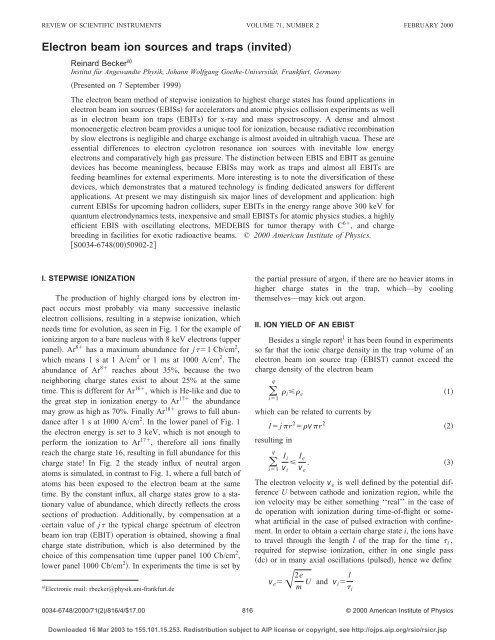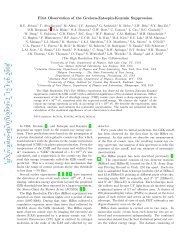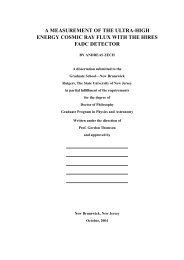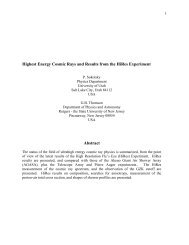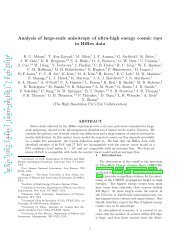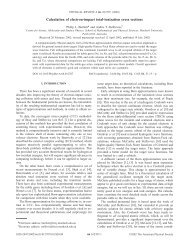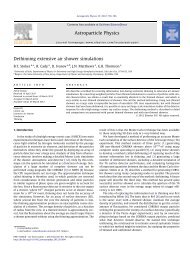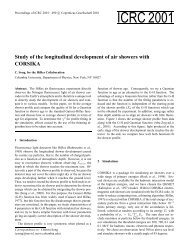Electron Beam Ion Sources And Traps (invited)
Electron Beam Ion Sources And Traps (invited)
Electron Beam Ion Sources And Traps (invited)
You also want an ePaper? Increase the reach of your titles
YUMPU automatically turns print PDFs into web optimized ePapers that Google loves.
REVIEW OF SCIENTIFIC INSTRUMENTS VOLUME 71, NUMBER 2 FEBRUARY 2000<br />
<strong>Electron</strong> beam ion sources and traps „<strong>invited</strong>…<br />
Reinard Becker a)<br />
Institut für Angewandte Physik, Johann Wolfgang Goethe-Universität, Frankfurt, Germany<br />
Presented on 7 September 1999<br />
The electron beam method of stepwise ionization to highest charge states has found applications in<br />
electron beam ion sources EBISs for accelerators and atomic physics collision experiments as well<br />
as in electron beam ion traps EBITs for x-ray and mass spectroscopy. A dense and almost<br />
monoenergetic electron beam provides a unique tool for ionization, because radiative recombination<br />
by slow electrons is negligible and charge exchange is almost avoided in ultrahigh vacua. These are<br />
essential differences to electron cyclotron resonance ion sources with inevitable low energy<br />
electrons and comparatively high gas pressure. The distinction between EBIS and EBIT as genuine<br />
devices has become meaningless, because EBISs may work as traps and almost all EBITs are<br />
feeding beamlines for external experiments. More interesting is to note the diversification of these<br />
devices, which demonstrates that a matured technology is finding dedicated answers for different<br />
applications. At present we may distinguish six major lines of development and application: high<br />
current EBISs for upcoming hadron colliders, super EBITs in the energy range above 300 keV for<br />
quantum electrondynamics tests, inexpensive and small EBISTs for atomic physics studies, a highly<br />
efficient EBIS with oscillating electrons, MEDEBIS for tumor therapy with C 6 , and charge<br />
breeding in facilities for exotic radioactive beams. © 2000 American Institute of Physics.<br />
S0034-67480050902-2<br />
I. STEPWISE IONIZATION<br />
The production of highly charged ions by electron impact<br />
occurs most probably via many successive inelastic<br />
electron collisions, resulting in a stepwise ionization, which<br />
needs time for evolution, as seen in Fig. 1 for the example of<br />
ionizing argon to a bare nucleus with 8 keV electrons upper<br />
panel. Ar 8 has a maximum abundance for j1 Cb/cm 2 ,<br />
which means 1sat1A/cm 2 or 1 ms at 1000 A/cm 2 . The<br />
abundance of Ar 8 reaches about 35%, because the two<br />
neighboring charge states exist to about 25% at the same<br />
time. This is different for Ar 16 , which is He-like and due to<br />
the great step in ionization energy to Ar 17 the abundance<br />
may grow as high as 70%. Finally Ar 18 grows to full abundance<br />
after 1sat1000 A/cm 2 . In the lower panel of Fig. 1<br />
the electron energy is set to 3 keV, which is not enough to<br />
perform the ionization to Ar 17 , therefore all ions finally<br />
reach the charge state 16, resulting in full abundance for this<br />
charge state! In Fig. 2 the steady influx of neutral argon<br />
atoms is simulated, in contrast to Fig. 1, where a full batch of<br />
atoms has been exposed to the electron beam at the same<br />
time. By the constant influx, all charge states grow to a stationary<br />
value of abundance, which directly reflects the cross<br />
sections of production. Additionally, by compensation at a<br />
certain value of j the typical charge spectrum of electron<br />
beam ion trap EBIT operation is obtained, showing a final<br />
charge state distribution, which is also determined by the<br />
choice of this compensation time upper panel 100 Cb/cm 2 ,<br />
lower panel 1000 Cb/cm 2 . In experiments the time is set by<br />
a <strong>Electron</strong>ic mail: rbecker@physik.uni-frankfurt.de<br />
the partial pressure of argon, if there are no heavier atoms in<br />
higher charge states in the trap, which—by cooling<br />
themselves—may kick out argon.<br />
II. ION YIELD OF AN EBIST<br />
Besides a single report 1 it has been found in experiments<br />
so far that the ionic charge density in the trap volume of an<br />
electron beam ion source trap EBIST cannot exceed the<br />
charge density of the electron beam<br />
q<br />
i1<br />
i e<br />
which can be related to currents by<br />
I jr 2 vr 2<br />
resulting in<br />
q<br />
I i<br />
I e<br />
.<br />
3<br />
i1 v i v e<br />
The electron velocity v e is well defined by the potential difference<br />
U between cathode and ionization region, while the<br />
ion velocity may be either something ‘‘real’’ in the case of<br />
dc operation with ionization during time-of-flight or somewhat<br />
artificial in the case of pulsed extraction with confinement.<br />
In order to obtain a certain charge state i, the ions have<br />
to travel through the length l of the trap for the time i ,<br />
required for stepwise ionization, either in one single pass<br />
dc or in many axial oscillations pulsed, hence we define<br />
v e 2e<br />
m U and v i l i<br />
1<br />
2<br />
0034-6748/2000/71(2)/816/4/$17.00 816<br />
© 2000 American Institute of Physics<br />
Downloaded 16 Mar 2003 to 155.101.15.253. Redistribution subject to AIP license or copyright, see http://ojps.aip.org/rsio/rsicr.jsp
Rev. Sci. Instrum., Vol. 71, No. 2, February 2000<br />
<strong>Ion</strong> sources<br />
817<br />
FIG. 1. Time evolution of argon charge states by stepwise ionization with<br />
feed of neutral atoms only in the beginning EBIS. Upper lower panel:<br />
<strong>Electron</strong> energy 8 3 keV.<br />
FIG. 2. Time evolution of argon charge states by stepwise ionization with<br />
continuous feed of neutral atoms EBIT. Upper lower panel: Compensation<br />
at j100(1000) Cb/cm 2 .<br />
and get from Eq. 3<br />
q<br />
i1<br />
I i i <br />
I el<br />
2e ,<br />
m U<br />
which may be related to the current I i in the desired charge<br />
state i by introducing an abundance factor f i , describing the<br />
relative abundance of charge state i in the charge spectrum<br />
giving<br />
f i <br />
I i i<br />
q ,<br />
j1 I j j<br />
I i f i I e l<br />
i<br />
2e .<br />
m U<br />
4<br />
5<br />
6<br />
Now we use the perveance for the electron beam<br />
PI e /U 3/2 and the relation of the ionization time i with<br />
electron current density j e and cross section i for stepwise<br />
ionization<br />
i e<br />
j e i<br />
to rewrite Eq. 6 in the following way:<br />
I i <br />
e 1<br />
f i PUlj e i 1.0510 13 f i PUlj e i ,<br />
2e<br />
m<br />
which, using<br />
N i I i<br />
ei i<br />
9<br />
and Eq. 7 may be turned into the more common expression<br />
for the number of ions, extractable after time i in pulsed<br />
mode<br />
7<br />
8<br />
Downloaded 16 Mar 2003 to 155.101.15.253. Redistribution subject to AIP license or copyright, see http://ojps.aip.org/rsio/rsicr.jsp
818 Rev. Sci. Instrum., Vol. 71, No. 2, February 2000 R. Becker<br />
FIG. 3. Stepwise ionization of C, N, O, Ne, Ar, Kr, Xe, and Pb. Left scale cross sections in cm 2 , right scale ionization time in s at 0.62 A/cm 2 .<br />
N i 1.0510 13 f i<br />
i PUl.<br />
10<br />
By applying a linear axial electrostatic gradient during ion<br />
extraction over the entire length of the trap volume, this<br />
number of ions may be extracted from the source within<br />
10–50 s, but by the induced velocity modulation—first ions<br />
have lower velocity than last ions—this amount of ions may<br />
be bunched at the entrance of the next acceleration device<br />
RFQ to even shorter pulses 1.5 s demonstrated for<br />
MEDEBIS 2 or 10 s expected for RHIC 3 . For synchrotron<br />
injection an EBIS may produce in this way ion currents in<br />
the mA range in short enough times for single turn injection,<br />
being beneficial for the simplicity of operation and low emittance,<br />
resulting in higher luminosity for a hadron collider<br />
RHIC.<br />
Analyzing Eqs. 8 and 10, we may ask ourselves<br />
about the limits to the electron beam parameters involved,<br />
namely the perveance P, the beam voltage U, the length l of<br />
the trap, and the electron beam current density j e . Clearly,<br />
the length is defined for practical reasons: 10 cm can be<br />
made longer easily, 1mismore or less standard, and 10 m<br />
seems to be a difficult task. In order to align all electrodes<br />
properly to the magnetic axis, a flux straightness of 10 4 is<br />
needed for thin beams and 0.1 mm radial accuracy is at the<br />
limit for a length of more than 1 m. The voltage should be<br />
taken high enough for an efficient ionization e times the<br />
ionization threshold and limited with respect to the beam<br />
power involved, which increases by I*UP*U 5/2 . Therefore<br />
the voltage will be also set with consideration of the<br />
perveance. The beam perveance P may reach a maximum of<br />
32.4 A/V 3/2 , if the beam is perfectly enclosed by a tube.<br />
Since this is impossible in practice, the maximum perveance<br />
will depend on the ratio of tube to beam radii, reasonably<br />
well approximated by the expression 4<br />
P lim <br />
32.4<br />
12.4ln r t<br />
r b<br />
A<br />
V 3/2 ,<br />
11<br />
resulting in P lim 10.1, 5.0, 2.7, 1.8, and 1.4 A/V 3/2 for<br />
r t /r b 2.5, 10, 100, 1000, and 10 000. We may conclude<br />
that for beams of some mm diameter the perveance may<br />
reach 10 A/V 3/2 , but only reach 2 A/V 3/2 for thin high<br />
density beams. It is worth noting that almost all EBIS devices<br />
are recuperating most of the beam energy by a depressed<br />
collector design which is also essential to allow<br />
axial ion extraction and that the gun perveance may be<br />
much less than the beam perveance by an appropriate deceleration<br />
of the electron beam between the gun anode and the<br />
trap electrodes.<br />
Finally, we will investigate the limits to the current density:<br />
The maximum current density is given by Brillouin focusing,<br />
which is not useful for EBISTs, because the beam<br />
will react immediately with its radius on the change of compensation,<br />
which occurs slowly during stepwise ionization<br />
and almost abruptly during ion extraction. Instead a more<br />
robust kind of focusing called immersed flow will be needed,<br />
where electrons seem to be attached to magnetic flux lines.<br />
The upper limit to immersed flow, however, is also given by<br />
the Brillouin limit. For highly compressed beams this Brillouin<br />
limit becomes reduced by thermal initial velocities of<br />
the electrons at the cathode and almost independent of the<br />
magnetic field at the cathode 5<br />
j lim e m<br />
4 B z I<br />
10 A<br />
2 .<br />
r c v t cm<br />
12<br />
Downloaded 16 Mar 2003 to 155.101.15.253. Redistribution subject to AIP license or copyright, see http://ojps.aip.org/rsio/rsicr.jsp
Rev. Sci. Instrum., Vol. 71, No. 2, February 2000<br />
<strong>Ion</strong> sources<br />
819<br />
The dc ion current Eq. 8 also depends on the electron<br />
current density j e , as given by Eq. 12, and the total cross<br />
section i for stepwise ionization see Fig. 2. For example,<br />
1A at 5 T from a cathode of 1 mm radius and 2000 K will<br />
result in j lim 10 5 A/cm 2 and with an ionization cross section<br />
of 10 20 cm 2 , which is the maximum value for Ne 10 and<br />
Ar 16 at 3–5 keV compare Fig. 3 we calculate an upper<br />
limit to the possible dc current according to Eq. 8 of 100<br />
A electrical. This allows us to provide interesting ion currents<br />
of highly charged ions at moderate charge states, as<br />
proposed for a so called TOFEBIS, 6,7 which is operating dc<br />
and provides stepwise ionization during the time-of-flight of<br />
ions through the length of the source. By raising the electron<br />
current density to its possible limits in high magnetic fields,<br />
demonstrated with the NIST EBIT, 8 where at 5000 A/cm 2 ,<br />
10 keV, 2 cm length, dc currents of some pA of Xe 44 ions<br />
were obtained, which however is still far below theoretical<br />
limits. This may probably be more conveniently accessible<br />
by the reflex mode of the operation of REFEBIS: 9 The power<br />
increase caused by an increase of U is almost insignificant<br />
and high perveances may be reached simultaneously with<br />
high current densities at low voltages. In addition, dc operation<br />
does not need individual drift tubes with the adverse<br />
chance of rf generation provided by axially oscillating electrons,<br />
but can be operated with only one single tube.<br />
In the past, EBISTs have been used for atomic physics<br />
experiments with either low perveance electron beams at<br />
high voltage Kryon-II and all EBITs or medium perveances<br />
at low voltages, as may be seen from Table 11.1 of Ref. 10.<br />
At present we are seeing a move to high perveances at medium<br />
voltages and moderate current densities at MSL, Stockholm<br />
as well as at BNL, Brookhaven, and IAP, Frankfurt.<br />
Making EBISTs work with megawatt electron beams as used<br />
in high power klystrons, will provide pulses of 10 10 ions/s,<br />
essentially useful for single turn injection into synchrotrons.<br />
III. ESSENTIALS OF EBIST TECHNOLOGY<br />
Besides providing the electron current density needed to<br />
create a desired charge state in required time, which is a<br />
straightforward engineering task, care must be taken to obtain<br />
the necessary vacuum level in the 10 10 –10 12 mbar<br />
range for classical pulsed operation with an ion confinement<br />
of a fraction of a second, or in the 10 8 –10 10 mbar range<br />
for dc operation. Vacuum is either spoiled by insufficient<br />
differential pumping between the trap region and gun and<br />
collector or by small electron losses in the A range in the<br />
trap region, which will cause generation of soft x-rays with<br />
subsequent desorption from a large surface, even under cryogenic<br />
conditions.<br />
The cathode material is chosen according to specific requirements.<br />
Proven long lifetimes up to 10 yr for TWTs in<br />
space communication systems may be expected from dispenser<br />
cathodes at a relatively low cathode loading of less<br />
than 0.2 A/cm 2 . This low current density at the cathode will<br />
need a considerable electrostatic and magnetic compression<br />
to reach interesting current densities, with an according increase<br />
of the transverse beam temperature, giving rise to<br />
Gaussian-like beam profiles. Higher emission current densities<br />
from monocrystalline LaB 6 Ref. 11 and IrCe Ref. 12<br />
alloy materials will reduce the transverse beam temperature,<br />
even at twice the operating temperature, however with some<br />
reduction of the lifetime, which is not acceptable for all applications.<br />
Other construction materials must be chosen with respect<br />
to their cryogenic and vacuum behavior, also with respect<br />
to differential thermal expansion across interfaces like<br />
electrical or thermal conductor versus insulator.<br />
IV. CONCLUSIONS<br />
EBISs have been successfully used for heavy ion acceleration<br />
in a synchrotron and future application may be for<br />
C 6 cancer therapy and for upcoming hadron colliders like<br />
RHIC at BNL, NY.<br />
EBITs became well established tools for—mostly<br />
spectroscopic—atomic physics studies on highly charged<br />
low energy ions. Super EBITs in the energy range above 300<br />
keV are in progress in several places and thorough QED tests<br />
will become possible, if ions like U 92 are available by reproducible<br />
production and extraction.<br />
Inexpensive and small EBISTs for atomic physics studies<br />
have been developed, which may produce interesting<br />
quantities of highly charged ions like: Ba 46 , Xe 44 , or<br />
Ar 18 . In the case of an eventual industrial application of<br />
creating craters of nm size on insulators by the impact of<br />
highly charged ions, these smart EBISTs will be preferable.<br />
A highly efficient EBIS using axially oscillating electrons<br />
is promising to enhance the number of extractable<br />
charges at only a modest decrease of the average electron<br />
density and may become a direct competitor to ECRs.<br />
In facilities for exotic radioactive beams, an EBIS may<br />
serve as a charge breeder with a special feature to selectively<br />
accumulate heavy ions by evaporative ion cooling.<br />
1 J. Arianer and C. Goldstein, The Orsay <strong>Electron</strong> <strong>Beam</strong> <strong>Ion</strong> Source, Proceedings<br />
Proc. IEEE NS-23, 1976, p. 979.<br />
2 R. Becker, H. Hoeltermann, M. Kleinod, A. Schempp, and B. Zipfel, The<br />
EBIS Option for Hadron Therapy, Proceedings of the 6th European Particle<br />
Accelerator Conference, Stockholm, Sweden, June 22–26, 1998 Institute<br />
of Physics, Bristol, 1998, p. 2345.<br />
3 E. Beebe, J. Alessi, S. Bellavia, A. Heshcovitch, A. Kponou, R. Lockey,<br />
A. Pikin, K. Prelec, G. Kuznetsov, and M. Tiunov, Results of <strong>Beam</strong> Tests<br />
on a High Current EBIS Test Stand, Proc. PAC-99, New York, 1999.<br />
4 R. Becker, Numerical Simulations in the Vicinity of the Virtual Cathode<br />
Regime, Proc. SCHEF-99, Dubna, 1999 in press.<br />
5 K. Amboss, Verification and Use of Herrmanns Optical Theory of Thermal<br />
Velocoity Effects in <strong>Electron</strong> <strong>Beam</strong>s in the Low Perveance Region,<br />
Proceedings, Proc. IEEE ED-11, 1964, p. 479.<br />
6 R. Becker, Successive <strong>Ion</strong>isation during Time of Flight, Proceedings ICIS<br />
2, Wien, Germany, Sept. 11–15, 1972, p. 640.<br />
7 M. Kleinod, R. Becker, H. Klein, and W. Schmidt, The Time-of-Flight<br />
EBIS with Unusual Cathode Operation, Proceedings, Proc. IEEE NS-23,<br />
1976, p. 1023.<br />
8 L. P. Ratliff, E. W. Bell, D. C. Parks, A. I. Pikin, and J. D. Gillaspy, Rev.<br />
Sci. Instrum. 68, 1998 1997.<br />
9 E. D. Donets, Rev. Sci. Instrum. these proceedings.<br />
10 Handbook of <strong>Ion</strong> <strong>Sources</strong>, edited by B. Wolf Chemical Rubber Corp.,<br />
Bocca Raton, FL, 1995, p.180.<br />
11 FEI <strong>Beam</strong> Company, www.feic.com/main.htm<br />
12 O. Kultashev, Phys. Scr. T71, 1271997.<br />
Downloaded 16 Mar 2003 to 155.101.15.253. Redistribution subject to AIP license or copyright, see http://ojps.aip.org/rsio/rsicr.jsp


